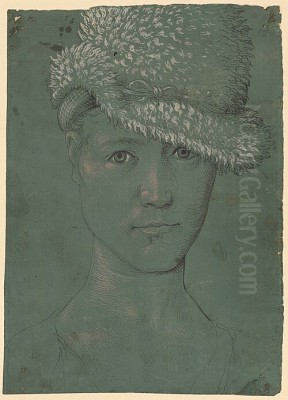
Hans Baldung, known distinctively as Grien, stands as one of the most original and compelling figures of the German Renaissance. Active as a painter, printmaker, draftsman, and designer of stained glass, Baldung navigated the turbulent artistic and religious currents of the early 16th century, forging a unique path that set him apart even from his renowned master, Albrecht Dürer. His work is characterized by vibrant, often unconventional color choices, dynamic compositions, and a profound fascination with the dramatic, the erotic, and the uncanny aspects of human existence, particularly themes of witchcraft, death, and the power of the female form. Born into an era of immense change, Baldung's art reflects the intellectual curiosity, spiritual anxieties, and evolving aesthetics of his time, leaving behind a legacy that continues to intrigue and provoke.
Origins and Early Training in Dürer's Shadow
Hans Baldung was born around 1484 or 1485, likely in Schwäbisch Gmünd, a free imperial city in Swabia, not far from Strasbourg where he would later spend much of his career. He hailed from a family of considerable standing and intellect; his father was a lawyer and judge, and other relatives were doctors and academics. Unusually for someone of his background during this period, Baldung did not pursue a university education, suggesting an early and decisive commitment to the visual arts. His family's connections and relative wealth likely provided him with advantages in pursuing his chosen craft.
The most formative period of his early career began around 1503 when he journeyed to Nuremberg to enter the workshop of Albrecht Dürer, the undisputed leader of the German Renaissance. This was a pivotal moment. Dürer's workshop was the most prestigious and innovative artistic center in Germany, attracting talented apprentices eager to learn from the master's technical brilliance and intellectual depth. Baldung quickly distinguished himself, becoming arguably Dürer's most gifted and trusted pupil. During Dürer's second trip to Italy (1505-1507), Baldung appears to have effectively managed the workshop alongside other apprentices like Hans Schäufelein and Hans von Kulmbach.
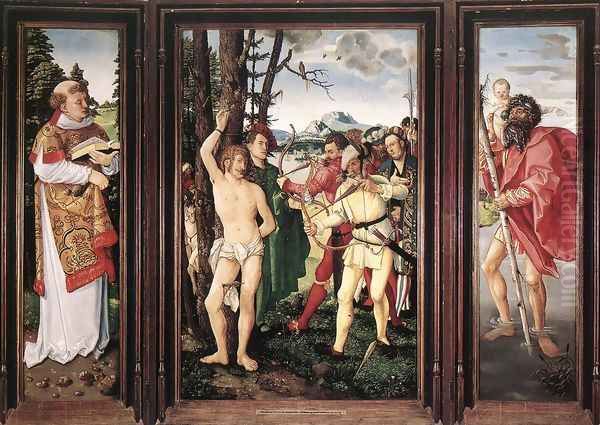
The relationship between Dürer and Baldung extended beyond a simple master-apprentice dynamic. They developed a close and enduring friendship. Evidence of this includes Dürer's documented efforts to sell Baldung's prints during his travels in the Netherlands later in life (1520-1521), and the poignant detail that upon Dürer's death in 1528, Baldung received a lock of his master's hair as a keepsake – a testament to their deep personal connection. Dürer's influence on Baldung is undeniable, particularly in the younger artist's mastery of printmaking techniques and his initial grounding in Renaissance principles of form and composition.
The Emergence of "Grien"
Sometime during his Nuremberg years, Baldung acquired the nickname "Grien" (Green). The exact origin remains debated among scholars, but several theories exist. The most popular suggests it stemmed from a fondness for the color green, perhaps evident in his clothing or prominently featured in his early works. Green was a relatively expensive and sometimes difficult pigment, and a preference for it might have been distinctive. Another theory posits that the name served to differentiate him from other apprentices named Hans in Dürer's busy workshop, such as Hans Schäufelein and Hans von Kulmbach. Whatever its origin, the moniker stuck, and Baldung often incorporated it into his monogram, HBG. This adoption of a distinguishing nickname highlights a growing sense of individual artistic identity early in his career.
Strasbourg: An Independent Master
Around 1507, Baldung left Dürer's workshop, his apprenticeship complete. After possibly spending some time working on commissions elsewhere, including potentially creating works like the Sebastian Altarpiece and an Epiphany Altarpiece in Halle, he made a decisive move. In 1509, he applied for citizenship in the prosperous and strategically important city of Strasbourg, located in the Alsace region. He was granted citizenship and joined the painters' guild "zur Steltz," marking his official establishment as an independent master. He married Margarethe Herlin, the daughter of a prominent local merchant, further integrating himself into the city's upper echelons.
Strasbourg would remain Baldung's primary base for the rest of his life, except for a period between roughly 1512 and 1517 when he relocated temporarily to Freiburg im Breisgau. This move was necessitated by a major commission: the creation of a large, multi-paneled high altarpiece for the Freiburg Minster (Cathedral). This monumental work, depicting the Coronation of the Virgin on the central panel, flanked by scenes from the life of Mary and portraits of donors, is considered one of the masterpieces of his career and a landmark of German Renaissance painting. Its complex iconography, rich color palette, and dramatic intensity showcase Baldung's mature style, which, while indebted to Dürer, clearly asserts its own powerful voice.
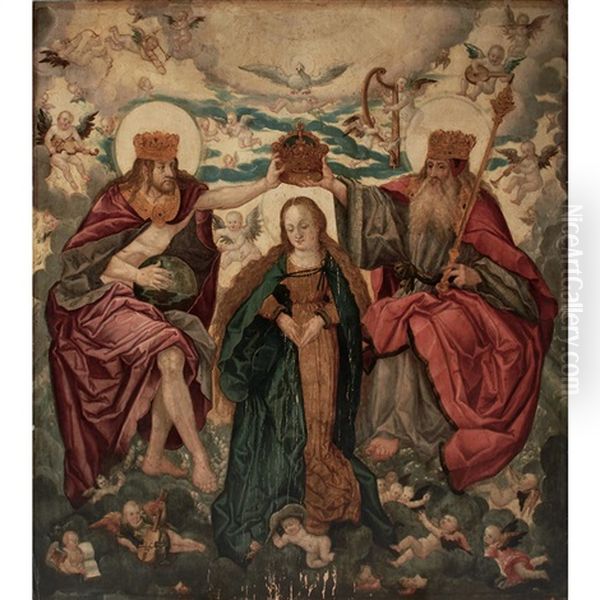
Upon completing the Freiburg altarpiece, Baldung returned to Strasbourg, where he purchased a house in 1518. He became a respected figure in the city, not only as a leading artist but also as a citizen. He served on the city's Great Council and held positions within his guild, reflecting his considerable social standing. His workshop flourished, producing paintings, prints, drawings, and designs for stained glass for a diverse clientele that included church officials, wealthy burghers, and potentially aristocratic patrons.
Artistic Style: Color, Drama, and Individuality
Hans Baldung Grien's artistic style is a fascinating blend of Northern Renaissance precision and a burgeoning Mannerist sensibility, infused with his unique psychological intensity. While deeply influenced by Dürer's technical mastery and Matthias Grünewald's expressive power, Baldung developed a highly personal visual language.
Color is a defining element of his work. He employed vibrant, often unexpected hues, using color not just descriptively but emotionally and symbolically. His palettes could range from jewel-like tones in religious scenes to eerie, phosphorescent greens and yellows in his depictions of witchcraft and the supernatural. This bold use of color contributes significantly to the dramatic impact of his compositions, setting him apart from the more restrained palettes sometimes favored by contemporaries like Albrecht Altdorfer or Lucas Cranach the Elder, though Cranach also explored vibrant color in his courtly works.
Compositionally, Baldung favored dynamic arrangements, often using strong diagonals, crowded spaces, and foreshortening to create a sense of energy and tension. His figures possess a physical presence and emotional weight, sometimes displaying exaggerated gestures or contorted poses that prefigure Mannerist aesthetics. This tendency towards the dramatic and the expressive is particularly evident when compared to the more classically balanced compositions often sought by Dürer or the idealized figures found in Italian High Renaissance art by masters like Raphael or Leonardo da Vinci.
Baldung's engagement with the human form, especially the female nude, is another hallmark of his style. He moved beyond the idealized forms of the Italian Renaissance, often depicting women with a raw, sometimes unsettling sensuality. His nudes can be both alluring and disturbing, charged with psychological complexity. This fascination with the power and vulnerability of the female body is a recurring motif, explored through biblical figures like Eve, mythological subjects, allegories, and his infamous witches.
Master of the Graphic Arts
Alongside his significant output as a painter, Hans Baldung Grien was a prolific and innovative printmaker, primarily working with woodcut but also producing some engravings. His graphic work allowed his imagery and ideas to circulate widely, contributing significantly to his fame and influence. He produced approximately 180 woodcuts and illustrations throughout his career.
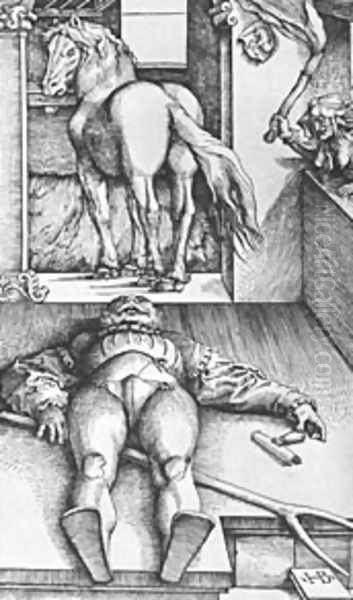
His woodcuts demonstrate exceptional technical skill and artistic vision. He mastered the traditional black-line woodcut technique inherited from Dürer and earlier masters like Martin Schongauer. However, Baldung also became one of the pioneers and most accomplished practitioners of the chiaroscuro woodcut in Germany. This technique involved using multiple woodblocks, inked in different tones (usually black for the key lines and one or more blocks for areas of color or tone), to create prints with a greater sense of depth, volume, and atmospheric effect. His chiaroscuro woodcuts, often featuring shades of green, ochre, or grey, possess a painterly quality and heightened emotional resonance.
Baldung's subject matter in printmaking mirrored his interests in painting: religious scenes, mythological narratives, allegories, and his signature themes of death and witchcraft. Prints like The Bewitched Groom (c. 1544), a complex and enigmatic woodcut, or the various depictions of witches, demonstrate his imaginative power and technical daring in the graphic medium. His series on the Ages of Woman and numerous Death and the Maiden compositions found potent expression in woodcut form, allowing these popular themes to reach a broader audience. His prints influenced contemporaries like Hans Burgkmair in Augsburg and later generations of Northern European printmakers.
Fascination with Witchcraft and the Supernatural
One of the most distinctive and often discussed aspects of Baldung's oeuvre is his intense preoccupation with themes of witchcraft, sorcery, and the demonic. Living in an age when belief in witchcraft was widespread and witch hunts were beginning to intensify, particularly in southwestern Germany and Alsace, Baldung tapped into these deep-seated cultural anxieties and fascinations.
His depictions of witches are far removed from later caricatures. They are often powerful, sensual, and disturbing figures, frequently shown nude, engaging in mysterious rituals, flying through the night sky, or concocting magical brews. The famous woodcut The Witches' Sabbath (1510) is a prime example, presenting a chaotic and orgiastic scene filled with naked figures, demonic creatures, and occult paraphernalia. These images are complex and open to multiple interpretations – are they condemnations of perceived female wickedness, explorations of the erotic and the forbidden, or perhaps even coded commentaries on social disorder?
Compared to the fantastical demons of Hieronymus Bosch, Baldung's supernatural scenes often feel more grounded in a specific, albeit dark, human reality. His witches are not merely abstract symbols of evil but possess a tangible, often unsettling physicality. This focus on the intersection of the human, the demonic, and the erotic makes his witchcraft images particularly potent and enduringly fascinating. Works like Bewitched Groom further explore the theme of malevolent magic impacting everyday life, blending the mundane with the terrifyingly supernatural.
The Ever-Present Theme of Death (Vanitas)
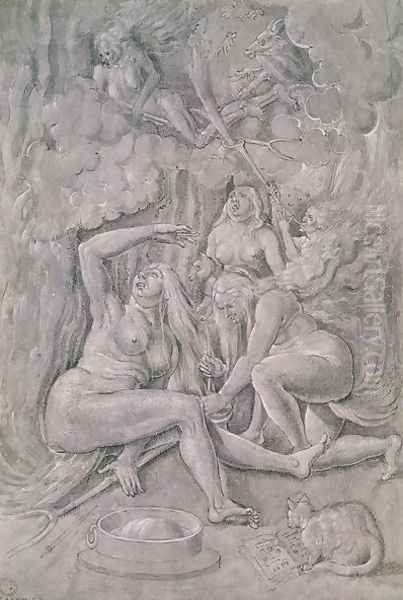
Alongside witchcraft, the theme of Death (often personified) is arguably the most persistent motif in Baldung's work. The memento mori (reminder of death) tradition was strong in late medieval and Renaissance Northern Europe, fueled by plagues, wars, and religious upheaval. Baldung engaged with this tradition profoundly, creating numerous variations on themes like Death and the Maiden and the Ages of Man/Woman.
In his depictions, Death is rarely a passive skeleton. It is an active, often aggressive figure, frequently shown interacting directly, even intimately, with the living. In Death and the Maiden compositions (like the versions in Basel, c. 1517, or Bern, c. 1520/25), Death confronts, embraces, or assaults a young, often nude woman, highlighting the fragility of beauty and the inevitability of decay. The erotic undertones in these encounters are often palpable and disturbing, suggesting a complex interplay between life, desire, and mortality.
The Three Ages of Woman and Death (e.g., Vienna, c. 1510) expands this theme, showing a child, a voluptuous young woman, and an aged crone confronted by Death, emphasizing the transient nature of life's stages. Baldung's treatment of these subjects is more visceral and psychologically charged than, for example, the more systematic, narrative approach seen in Hans Holbein the Younger's famous Dance of Death woodcut series. Baldung focuses on the dramatic, often violent confrontation between life and its ultimate end. This morbid fascination also connects him thematically to Swiss contemporaries like Niklaus Manuel Deutsch, who also explored themes of death and mercenaries with stark realism.
Portraying the Human Condition: Portraits and Allegories
While renowned for his dramatic and supernatural themes, Baldung was also a capable portraitist. Although fewer portraits survive compared to his religious or allegorical works, examples like the portrait of Count Christoph I of Baden (1515) demonstrate his ability to capture a sitter's likeness and convey a sense of individual presence. His portraits often possess a psychological acuity, hinting at the inner life of the subject, a quality shared with the best portraitists of the era, including Dürer and Holbein.
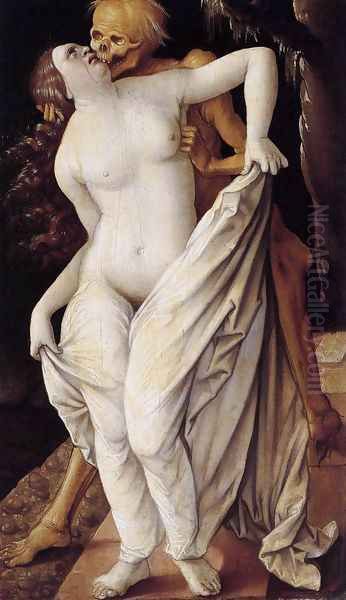
Baldung also excelled in creating complex allegorical works. Paintings like Hercules and Antaeus or Mucius Scaevola before Porsenna drew on classical mythology and history, reflecting the humanist interests of the Renaissance. However, even these subjects were often imbued with Baldung's characteristic dynamism and emotional intensity. Other works, like the enigmatic panels sometimes interpreted as Allegory of Music and Allegory of Prudence (or Vanity), use symbolic imagery, often centered around female figures, to explore abstract concepts. His depictions of Adam and Eve, while biblical, also function as profound allegories of temptation, sin, and human frailty. The Flood highlights female figures amidst chaos, exploring themes of fear and survival.
The Impact of the Reformation
Hans Baldung Grien lived and worked through the tumultuous early years of the Protestant Reformation, which had a significant impact on Strasbourg and the broader artistic landscape of Germany. Strasbourg officially adopted the Reformation in the 1520s, leading to a decline in traditional Catholic commissions, such as large altarpieces and devotional images for churches.
Like many artists of his generation, Baldung adapted to these changing circumstances. While he seems to have remained personally Catholic (or at least maintained connections with Catholic patrons, as evidenced by the Freiburg altarpiece completed just before the major shifts), his later work shows an increasing emphasis on secular themes. Portraits, mythological subjects, allegories, and prints became more central to his output as religious commissions waned. His exploration of classical and humanistic themes intensified during this period. This shift mirrors trends seen elsewhere, although artists like Lucas Cranach the Elder successfully navigated the Reformation by becoming closely associated with Protestant leaders and producing art that aligned with Lutheran ideology. Baldung's path seems more focused on adapting his existing thematic interests to a changing market.
Later Years and Enduring Legacy
Hans Baldung Grien remained a prominent and respected figure in Strasbourg throughout his later life. He continued to run a successful workshop and maintained his civic roles. His artistic output remained significant, particularly in the realm of drawings and prints. He died in Strasbourg in September 1545. His workshop and artistic estate were apparently inherited by Nikolaus Kremer (sometimes referred to as Kriecher or Kulak), who had married Baldung's daughter.
Baldung left behind a substantial body of work, including roughly 90 paintings and altarpieces, around 350 drawings (highly valued for their spontaneity and technical brilliance), and over 180 prints and book illustrations. His influence extended through his prints, which circulated widely, and potentially through students, though Kremer is the only one clearly documented.
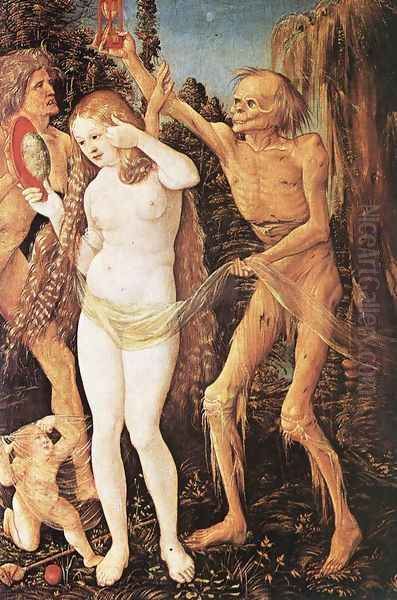
His legacy is that of a highly individualistic master who, while emerging from the towering influence of Albrecht Dürer, carved out a unique artistic territory. He stands alongside Matthias Grünewald, Albrecht Altdorfer, Wolf Huber, and Lucas Cranach the Elder as one of the key figures of the German Renaissance, contributing significantly to its diversity and expressive power. His bold use of color, dramatic compositions, and unflinching exploration of complex themes like death, witchcraft, and human sensuality distinguish his work. While sometimes overshadowed by Dürer, Baldung's art offers a powerful, often unsettling, but always compelling vision of the human condition during a pivotal era of European history. His work continues to be studied and admired for its technical virtuosity, imaginative force, and psychological depth, securing his place as a major, albeit sometimes enigmatic, master of Renaissance art.